Do *Not* Crush A Tick If You Caught It Biting You (Even If You Really Want To)
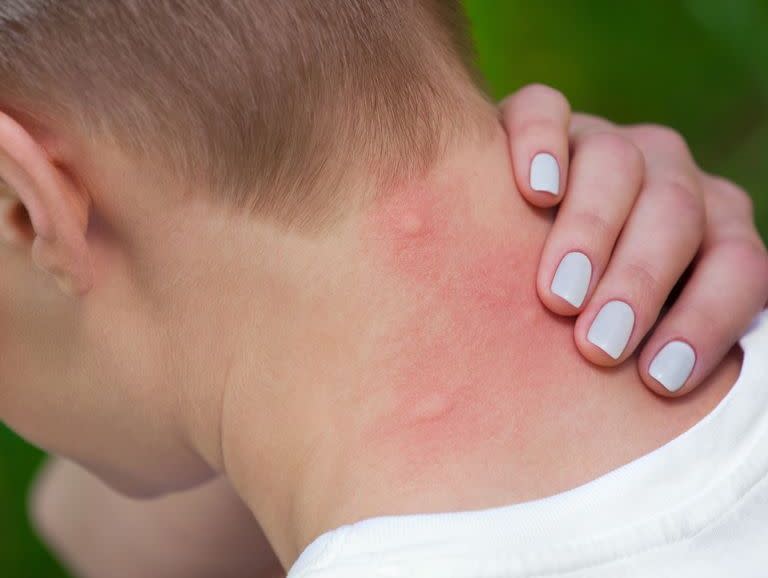
"Hearst Magazines and Yahoo may earn commission or revenue on some items through the links below."
We’ve likely all had a creepy (and usually very itchy) bug bite experience. Yes, you might want to just scratch the darn spot and move on, but it’s wise to try and figure out exactly what bit you. While some are relatively harmless, others can lead to more serious health issues if not treated appropriately.
Figuring out the exact type of bug bite may be hard, but narrowing it down to a few categories can help provide clarity. There are simple bites, stings where the bug that bit you actually has venom, and then there are infestations where a bug is actually living in your skin, explains Meyer Horn, MD, a dermatologist and assistant professor of clinical dermatology at the Feinberg School of Medicine of Northwestern University. “Bites look pretty much the same, so it depends on the distribution of where they are on the body, or how many bites people have,” he adds.
Where you live and your recent activity can provide some insight as well, says Peggy Hunter, MD, a dermatologist and fellow of the Academy of Dermatology. Outdoor activity, travel, regions of the world, animal contact, or dense vegetation can all serve as clues.
An uncomplicated bite resolves gradually over days to weeks, and is not accompanied by general changes in health status, notes Dr. Hunter. But if the itching or pain continues, or if you develop fevers, chills, muscle cramps, sweating, diarrhea, vomiting, neck stiffness, lip swelling, or wheezing, contact your doctor.
Learn about most common insect bites you may encounter and what to do for each.
Meet the experts: Meyer Horn, MD, is an assistant professor of clinical dermatology at the Feinberg School of Medicine of Northwestern University and a diplomate of the American Board of Dermatology. His special interests include inflammatory diseases of the skin, skin cancer screening, prevention and education, and surgical dermatology.
Peggy Hunter, MD, is a dermatologist with more than 10 years of experience. She is also a diplomat of the American Board of Dermatology and a fellow of the American Academy of Dermatology. She has spoken professionally at regional dermatology meetings, published chapters in a dermatology reference book, and written articles featured in peer-reviewed journals.
Bed Bug Bites
While the thought of bed bug bites may skeeve you out, they’re more annoying to deal with than an actual threat to your health, according to the Centers for Disease Control and Prevention (CDC). Bed bug bites are primarily just super itchy and can keep you up at night. The bigger issue with these pesky bugs is that they can spread really fast and lead to an infestation, and it can be an inconvenient and expensive process to get rid of one. (Also, the idea of little bugs feeding on your blood while you sleep isn’t exactly a comforting thought.)
People can have a range of reactions to bed bug bites, says Nancy Troyano, PhD, a board-certified entomologist with Rentokil North America. Some people have no reaction at all when bitten, but most people will notice an itchy, red, welt-like mark that looks similar to a mosquito bite, Troyano says. “Bites may appear in a linear fashion if there are multiple bugs feeding, and bites can occur anywhere, but they are often found in areas where skin is readily exposed,” she notes. They may appear pink or deep purple on dark skin and red on light skin.
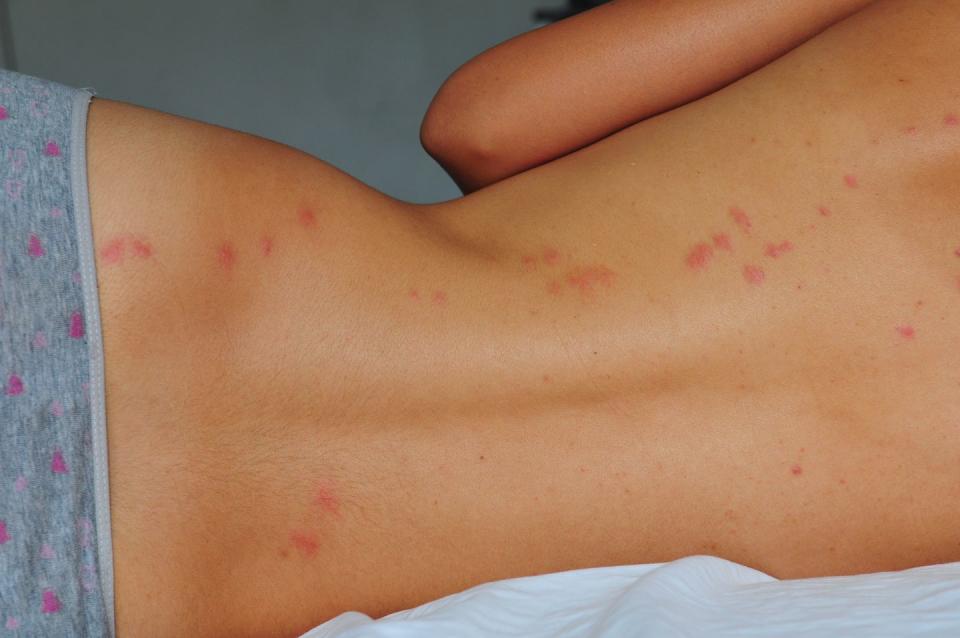
Contrary to popular belief, attracting bed bugs has nothing to do with bad hygiene or a dirty apartment. Bed bugs get around by hitchhiking onto your things, so prevention can be tough, says Angela Tucker, PhD, the manager of technical services for Terminix. “Knowing this, the best prevention for bed bugs is being watchful during your travels and regular home cleaning,” she says.
You can also keep an eye out for the critters, which are about the size, shape, and color of an apple seed when fully grown. Another sign that bed bugs may be around your space is their byproduct, meaning you might see reddish-brown blood spots on sheets or mattresses, Tucker says.
If you do happen to get bed bug bites, spot-treat them with hydrocortisone cream to try to soothe itch, says David Cutler, MD, a family medicine physician at Providence Saint John’s Health Center in Santa Monica, California. Then, get rid of the infestation—with the help of a professional. “It’s important to see where the bed bugs came from,” Dr. Cutler says. “Then, call in a professional exterminator so you don’t get any more bed bug bites.”
Bee and Wasp Stings
You’ll usually know it when you get stung by a bee or wasp, because it hurts like hell. “At first, you may not even see anything on the skin," Troyano says. "However, within a few minutes of being stung, there may be localized swelling and redness around the sting site.” The area might also feel warm, and you might see a small white mark near the center of the swelling (that’s where the stinger went into your skin), she describes. On darker skin tones, you may see a swollen red bump with a dark red or black mark in the center.
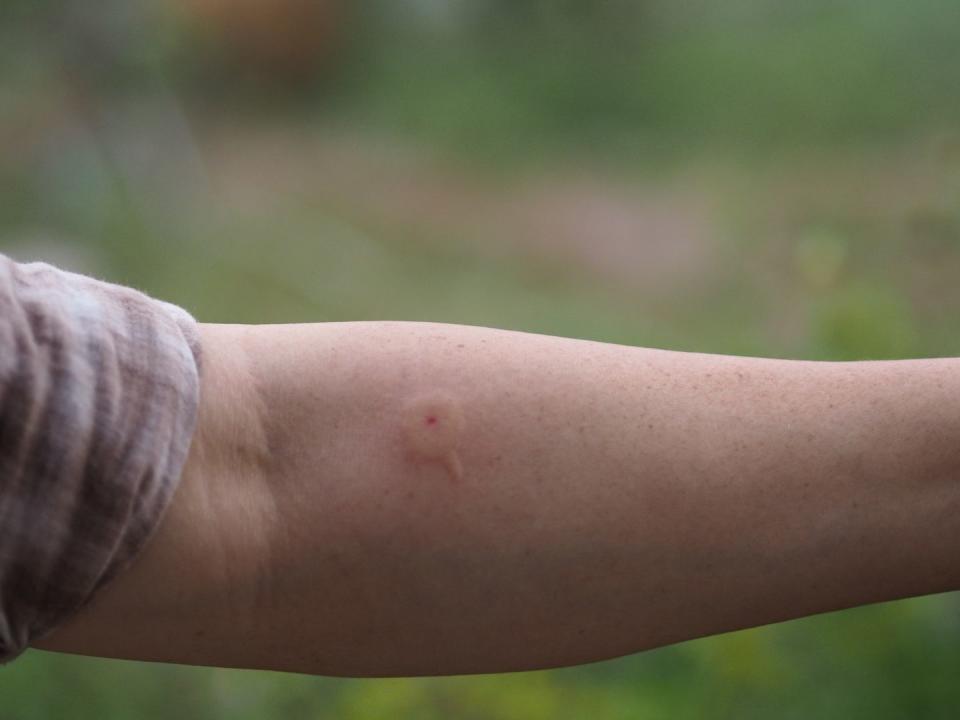
If you know you have an allergy to bee or wasp stings, follow instructions from your doctor and seek medical care immediately. But if you’re not allergic, you’ll still want to take action. Bees lose their stinger after stinging, Troyano says, and you should try to remove it if it’s still stuck in you.
Then, apply ice to reduce swelling, says David Gatz, MD, an assistant professor of emergency medicine at the University of Maryland School of Medicine and the assistant medical director of the adult emergency department. You also may want to take an antihistamine like Benadryl, he says.
The only real way to totally avoid getting stung is to not interact with bees and wasps...obviously. (But that's not a feasible lifestyle if you ever want to enjoy the outdoors!) So, when you're outside, don't swat at these insects—just let them be. “In general, if you leave bees and wasps alone, they will leave you alone,” says Tucker.
If you want to be especially cautious, she also recommends skipping flowery perfumes or fragrances and covering any food and drink around you.
Scabies
Scabies is a parasite infestation caused by microscopic mites, according to the CDC. When you have scabies, the female burrows into your epidermis to lay her eggs.
Scabies usually shows up as a rash with small, raised pustules or blisters, and is “intensely itchy,” Troyano says. They are often clustered together and look like inflamed pink or dark red pimples.
If you’ve never had scabies before, you might not see the rash for several weeks after you’ve been exposed. But, if you’ve had scabies before, you might see a rash within one to four days of being exposed, she says.
Examining a patient's hands, feet and lower legs will catch more than 90% of #scabies cases. https://t.co/LYSWxwz7yE pic.twitter.com/qmEcIR9J6E
— Medscape (@Medscape) January 7, 2019
Scabies is transmitted through “prolonged direct skin contact” and is “highly contagious,” Tucker says. You need to see a doctor to get properly diagnosed and treated, but it’s generally treated with a permethrin anti-parasitic cream, Dr. Gatz says.
Mosquito Bites
Okay, yes, mosquito bites are usually NBD. They’re itchy and annoying, but nothing major to worry about. You probably already know what a mosquito bite looks like, but (just in case), they’re usually red, create a bump on your skin, and can itch, per Troyano. On darker skin tones, bites can appear dark red or brown and may appear slightly raised. For some people, a bug bite may appear filled with fluid, with a small water blister in the center.
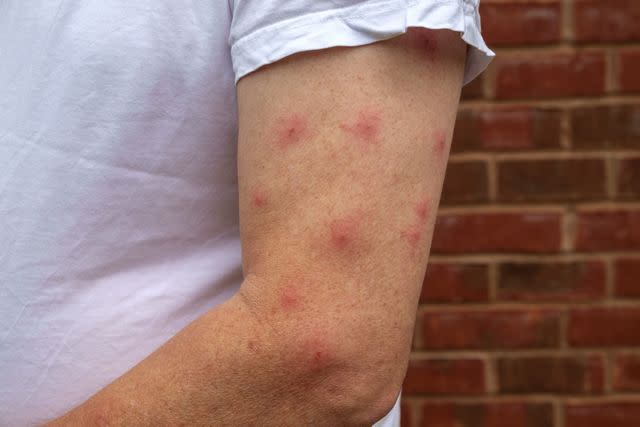
That said, mosquitos can carry viruses like Zika and West Nile, which can cause fever-like symptoms, rash, joint pain, and red eyes, the CDC says. So, if you’ve been bitten by a mosquito and start to feel off afterward and have symptoms like these, call your doctor ASAP.
In order to let mosquito bites heal, do your best not to scratch; that raises the risk that the bite will get infected, Dr. Cutler says. A hydrocortisone cream should help alleviate some of the itch, he says.
While you can only do so much to prevent mosquito bites, Tucker recommends removing standing water around your home or yard (mosquitoes can lay their eggs in these areas). And, if you’re planning to spend a lot of time outside, using a good mosquito repellent is key, she says.
Spider Bites
Spider bites are actually pretty rare, Troyano says, but they do happen. They can look like typical bug bites, so it can be hard to tell right away if you were bitten by a spider unless you see it scuttling away.
If you do notice a bite and spot the little guy, Dr. Cutler recommends washing the area with soap and water and leaving it alone. “Toxins from [certain spiders] can destroy the skin,” he says—so it never hurts to wash the spot with soap and water to cleanse the skin (even if you're not 100 percent sure it's a spider bite). For those with deeper skin tones, the redness can be more subtle and the bite may appear brownish. Sometimes, spiders also leave behind two puncture holes right next to each other.
If the wound area seems to be growing, is unusually red, hot to the touch, or ulcerated, or you have a fever and/or joint pain, call your doctor ASAP, Troyano says.
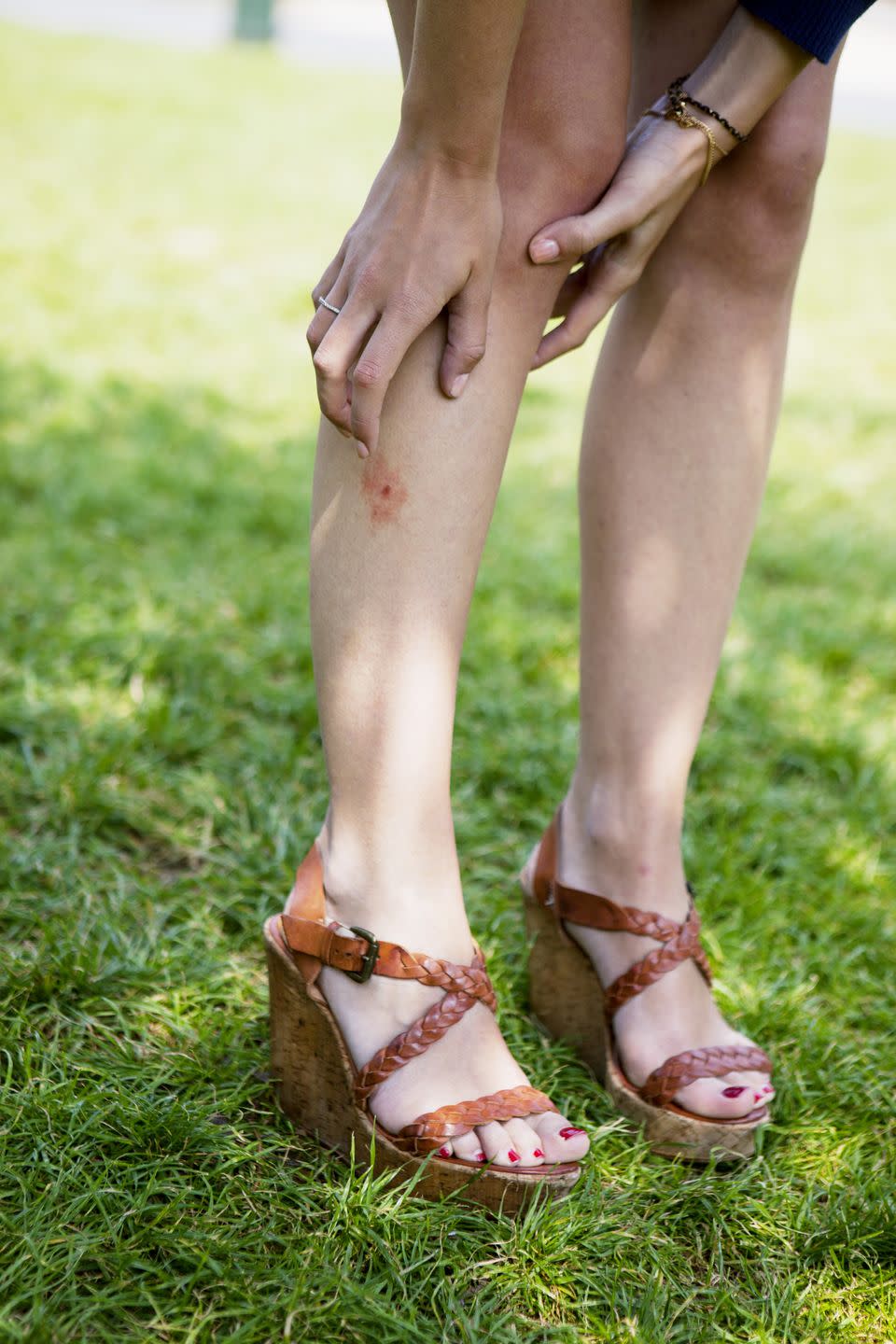
Cleaning out cobwebs inside and outside of your house can reduce your chances of spider run-ins. Also, wear long sleeves, pants, gloves, and a hat to protect your skin when you’re working outside or in areas where things are stored and not used often, and try to keep your grass and bushes maintained, Tucker says.
Tick Bites
It's not always obvious when a tick bites you, because it won't *always* leave a mark (more on that in a minute). But sometimes the tick will still be attached when you discover a bite, so the first thing you’ll want to do is remove it. Troyano recommends taking the following steps to do this:
Use tweezers and grab the tick close to the skin.
Steadily pull upward, but avoid twisting the insect.
Don't crush the tick once removed.
Submerge the tick in rubbing alcohol and save it. Put it in a clear, sealable plastic bag in case you need to see a doctor or veterinarian. Or, take a clear photo, then flush it.
Once the tick is removed, wash the area with soap and water, Dr. Gatz says.
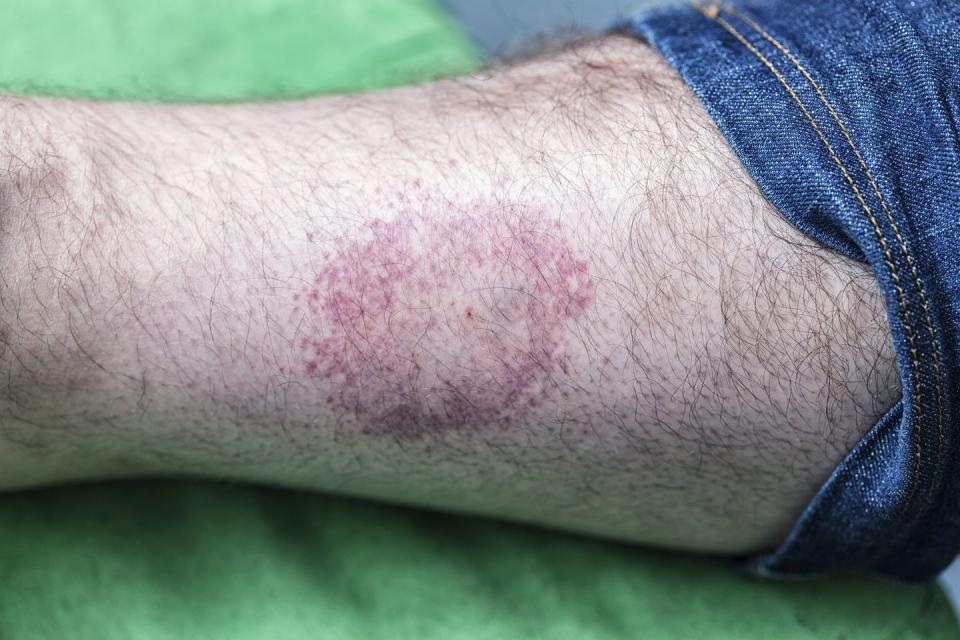
Most likely, you won’t be able to feel when a tick bites you. The bite is usually painless, but can appear as a tiny red dot. If you notice a bullseye-shaped rash appear on your body, a pink rash on your wrists, arms, and ankles, or an ulcerated area around a bite, call your doctor, Troyano says. These symptoms may be signs that a tick did bite you, and you've been infected with a tick-borne illness like Lyme disease. On darker skin tones, the small bite may appear brown or purple. If you experience a fever, chills, aches, and muscle fatigue, those are also cues you need to make a visit to your doctor.
But remember, not every tick carries a tick-borne illness, so even if one bit you at some point, that doesn't guarantee you contracted something more serious.
How can you protect yourself from tick bites? Tucker recommends showering quickly when you come in from being outside (you might be able to wash off ticks before they have a chance to bite you). It’s also a smart idea to wear long pants and sleeves when you go into tick-infested areas, like the woods, and to wear bug repellent that contains DEET. Also ask a family member or friend to help you do a body scan for ticks after being out in the woods.
Fire Ant Bites
Fire ant bites are common in the summer, and chances are, if you are stung, you will probably have more than one bite. A single fire ant can sting multiple times (ugh!), and if you are stung, you’ll know as soon as it happens. “Fire ants cause immediate pain and a red spot,” says Dr. Hunter. “[They are] typically a collection of swollen red blisters which eventually evolve into tender, itchy, pus-filled bumps.” And unfortunately, those painful blisters can last for several days to weeks.
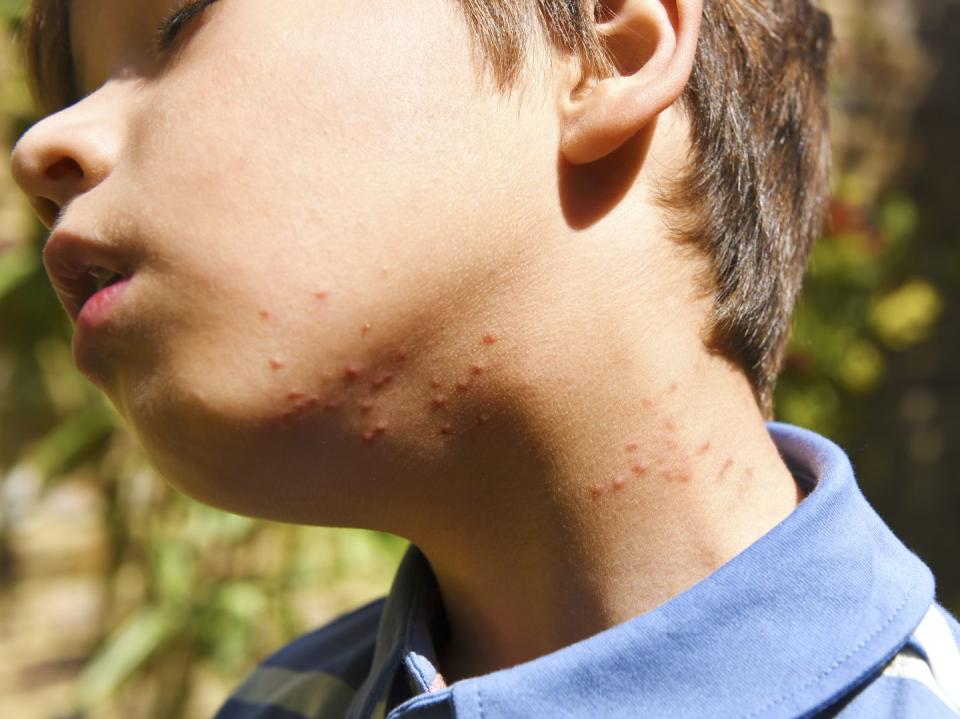
If you suspect you were bitten by fire ants, immediately wash the skin with soap and water. Then, Dr. Hunter suggests applying a cool compress, calamine lotion, hydrocortisone cream, or an OTC methanol-based, anti-itch solution to help soothe the itching and discomfort. Home remedies like baking soda and water paste, white vinegar-soaked cotton balls (cooled in the refrigerator), and toothpaste can also provide relief.
In extreme cases, an oral antihistamine provided by a medical provider may be necessary. It’s also important to note that if you are allergic to bees, and suspect you have been stung by fire ants, you should seek medical care immediately. “If there is a pre-existing bee or wasp allergy, there is a potential for cross-reactivity with the venom from fire ant bites,” says Dr. Hunter. Since bees and fire ants are both classified in the Hymenoptera order, people with a history of anaphylaxis to stings should carry an EpiPen, regardless of the species that bit them, she explains.
To avoid a run-in with fire ants, don’t walk barefoot outside. Wear socks and closed-toe shoes if you are in grassy, sunny, open areas. Spraying insect repellent on shoes and clothing can also help prevent fire ant stings, says Dr. Hunter. “Be aware of your surroundings,” she says. “Fire ant attacks take merely seconds, but the consequences last days to weeks.”
Flea Bites
Fleas are tiny insects that survive on animal or human blood and reproduce quickly. While they are commonly associated with pets, you can still get flea bites if you live in a pet-less home. Fleas can come from your yard or a neighbor too.
Female fleas lay eggs after feeding on blood, per the Cleveland Clinic. Typically, fleas bite below the knee, but if you are a pet owner (and sleep with your pet), your entire body may be at risk. “Flea bites look like a miniature version of mosquito bites,” Dr. Horn says. The red or dark brown bumps are often clustered with three bites in a row within an area spanning several centimeters.
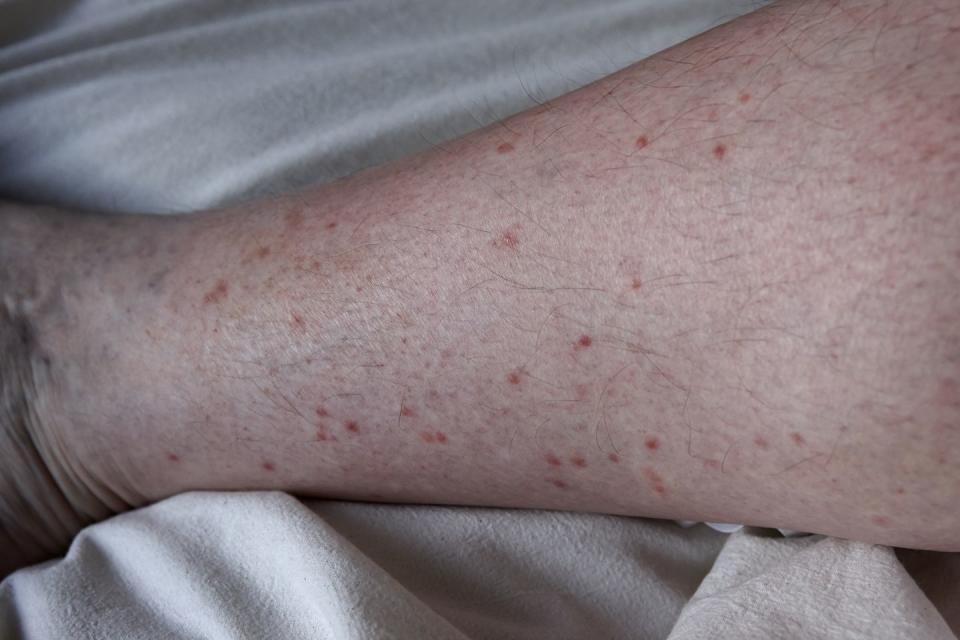
The main signs are intense itchiness and tenderness around the bite. But do not scratch! “Some of the most severe cases are not from the bites themselves, but secondary to all the scratching people have done, and they get an infection requiring antibiotics,” says Dr. Horn. That said, some fleas do carry disease or bites can cause an allergic reaction. In these cases, you may experience more severe symptoms like fever, body aches, and rashes.
Dr. Horn suggests taking an over-the-counter oral antihistamine such as Claritin, Allegra, Zyrtec, or Benadryl. You can also use a cortisone lotion or cream, as well as an OTC anti-itch remedy containing camphor and menthol, he says. For added relief, put the creams in the refrigerator and use them cold to cool and soothe the bites.
Insect repellent that has DEET is especially effective for warding off fleas, says Dr. Horn. “DEET is really necessary if you want good protection,” he says. Just avoid spraying it directly on your face or near your mouth. And if you suspect a friend or neighbor has a flea issue, call your landlord or an exterminator to help determine the best course of action.
Chigger Bites
Chiggers are mites that are not primarily interested in humans, and typically come from birds or other animals. Unfortunately, as the weather gets warmer and people open their windows, chiggers can enter through screens if a bird is perched on the window sill.
Chigger bites are very similar to flea bites and almost impossible to distinguish, says Dr. Horn. “It’s more about history of exposure, but chigger bites are going to be more common,” he notes. Bites usually look like red or dark brown welts, appear in groups, cause intense itchiness, and are typically found on the lower body.
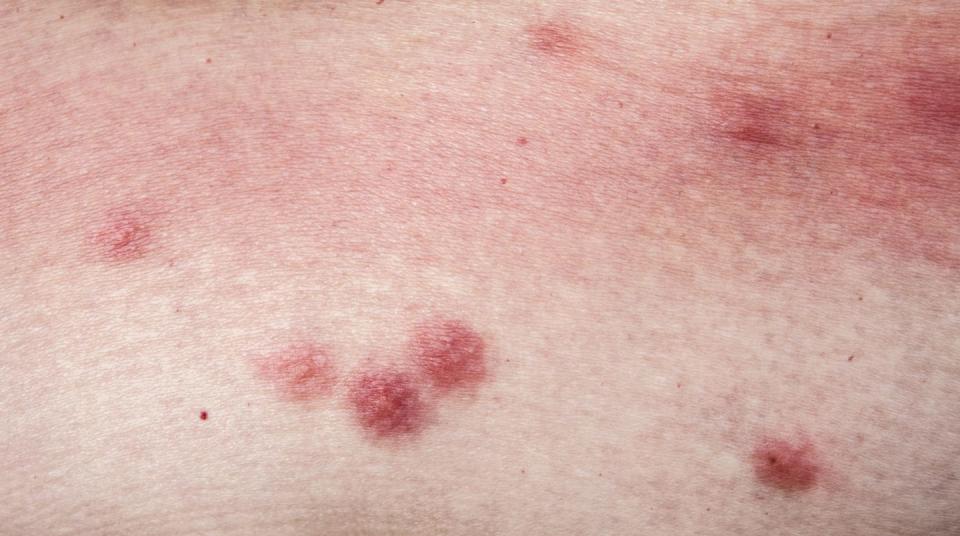
They tend to get better in a few days. To help calm the itchiness, oral antihistamines like Claritin, Allegra, Zyrtec, or Benadryl can help, as well as cortisone lotion and over-the-counter anti-itch creams, says Dr. Horn. Whatever you do, do not scratch it. The temporary relief you get may also bring a bacterial infection or cause the area of discomfort to get even bigger.
To minimize your risk of chigger bites, check for bird nests before opening your windows. During outdoor activities and camping, always wear DEET insect repellent, says Dr. Horn. “I usually tell people that are camping to wear insect repellent on their clothes, and pat it onto their hands, neck, cheeks, and hairline.” Noted!
You Might Also Like

